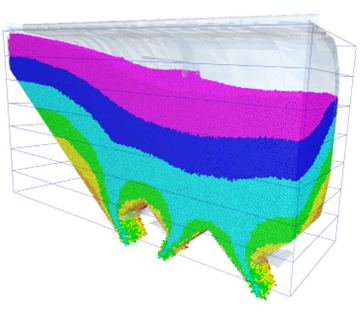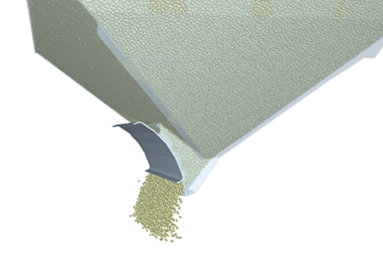Partner: Advanced Engineering, s.r.o.
Field: Transport
Advanced Engineering is a well-established Czech technology and engineering company that focuses on computer simulations, structural analysis, and optimisation of structures as well as multi-physics modelling and simulations. TATRAVAGÓNKA is currently one of the most important manufacturers of railway freight wagons and bogies in Europe. It draws upon the century of its existence, experience in the production of more than 130,000 freight wagons in almost 150 different designs, and the production of approximately 400,000 bogies.
The development team of Tatravagónka in collaboration with Advanced Engineering have implemented a pilot project to simulate the process of unloading a newly developed freight wagon. It is a 103 m³ Tagnpps model designed especially for grain transport. End customers and users asked for a guarantee for the time required to unload each wagon during unloading, and the development team needed to make sure that the geometry of the hoppers and funnels would ensure the complete discharge of bulk material without it being stuck to the walls.

For this type of simulation, CAE specialists from Advanced Engineering use the Altair EDEM software tool, which is a leading solution for Discrete Element Method (DEM) simulations. The basis of DEM simulations is the tuning and validation of the computational model. However, the tricky part of the freight wagon problem is its scale, given the cargo area dimensions and the size of the particles; in other words, the number of elements representing the grains, which for such a problem are in the order of millions. For each element and each time step, the DEM calculates the interactions of the particles with respect to each other and to their surroundings; in summary, we get a simulation of the grain discharge flow that allows us to observe how the different layers of the load are discharged. The aforementioned problem of computational complexity and required computing power can be solved by using High-performance computing (HPC).
The original task was further solved in collaboration with the IT4Innovations National Supercomputing Centre by scaling this type of problem to variously dimensioned compute nodes of the supercomputer. From the users’ perspectives, it was important to determine what the real-time requirements for these simulations were and what costs would be incurred for further simulations. Advanced Engineering also needed to know where the performance breaks were, i.e. what number of processors used is most efficient in terms of the speed and cost of computations. Another question was to compare the performance and cost-effectiveness of computing on standard (CPU) or graphics processing units (GPU). And this issue was the content of the cooperation with the National Centre of Competence in HPC, which used supercomputers operated by the IT4Innovations National Supercomputing Centre.

The solution both validated the correctness of the design of the new type of freight wagon and verified the solvability of the problem, especially with respect to the computational complexity. In the first stage, the design and validation of the material model using larger particles were carried out. This was followed by actual calculation and simulation of the discharge process, and calculation of the tangential and radial forces acting on the clamping mechanism. Then, in the second stage, a simplified physical test was carried out with a partially loaded freight wagon hopper to validate the model from the first stage. Variations due to the real variance of grain size, the shape of different wheat varieties, and the variance of physical parameters (density, friction) at different temperatures and humidity levels were confirmed.
Tomáš Čurda, Business Development Manager, Advanced Engineering, s.r.o.
“The advantage of computer simulations of bulk material movement for this problem over physical testing is that the cost of hiring grain silos and grain costs are eliminated. An additional benefit is the ability to simulate the interaction of the bulk material with the structure, the ability to compare multiple design options, and the ease of analysing the behaviour of different grain types under a variety of external conditions such as temperature and humidity. The simulations were performed in parallel using both the conventional infrastructure at Advanced Engineering and the supercomputers at IT4Innovations. The hardware complexity of the bulk material movement simulations is shown in the following figures. The simulation of a partially simplified model of 2.8 million particles on a conventional workstation with 16 CPU cores required 130 hours. However, it is possible to validate a more reduced simulation model and perform further simulations using the same hardware in only 33 hours. However, if we use HPC infrastructure with GPU computing, then the computational time drops to 9 hours. This gives us a real opportunity to simulate multiple design variants or optimise them. The scalability benchmark then confirmed the advantage of GPU computing also in terms of cost, where the software licensing costs are a crucial item.”


